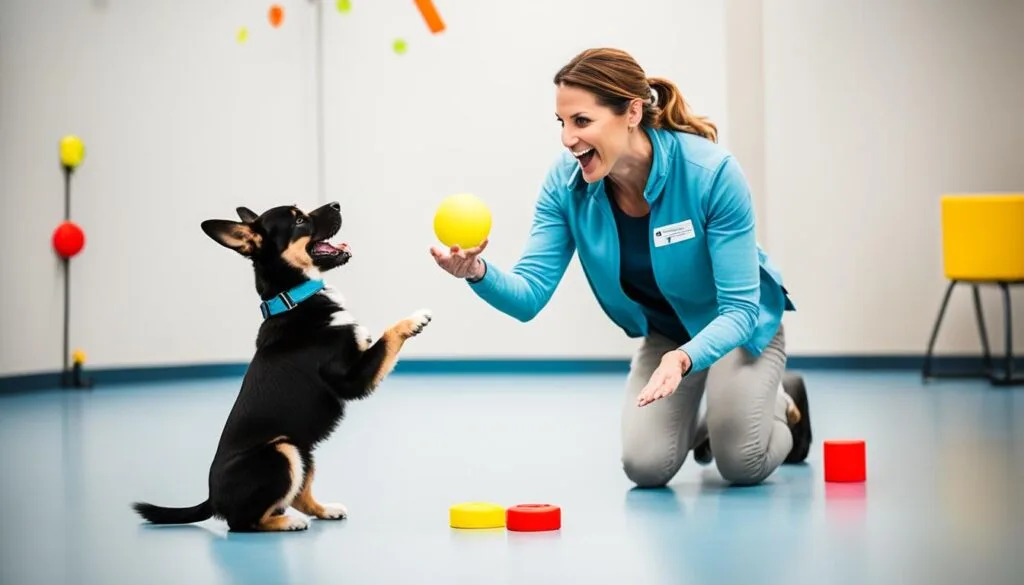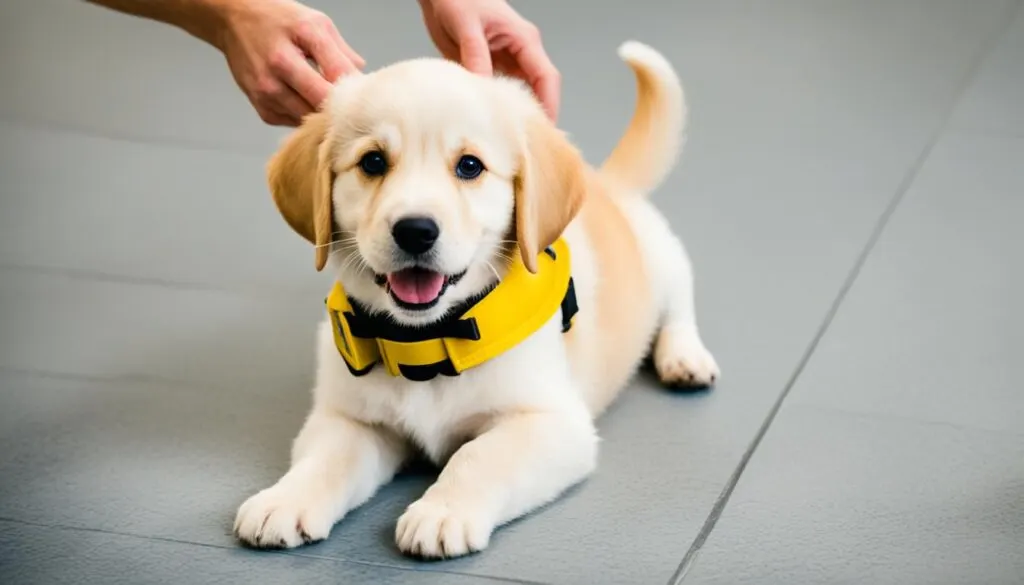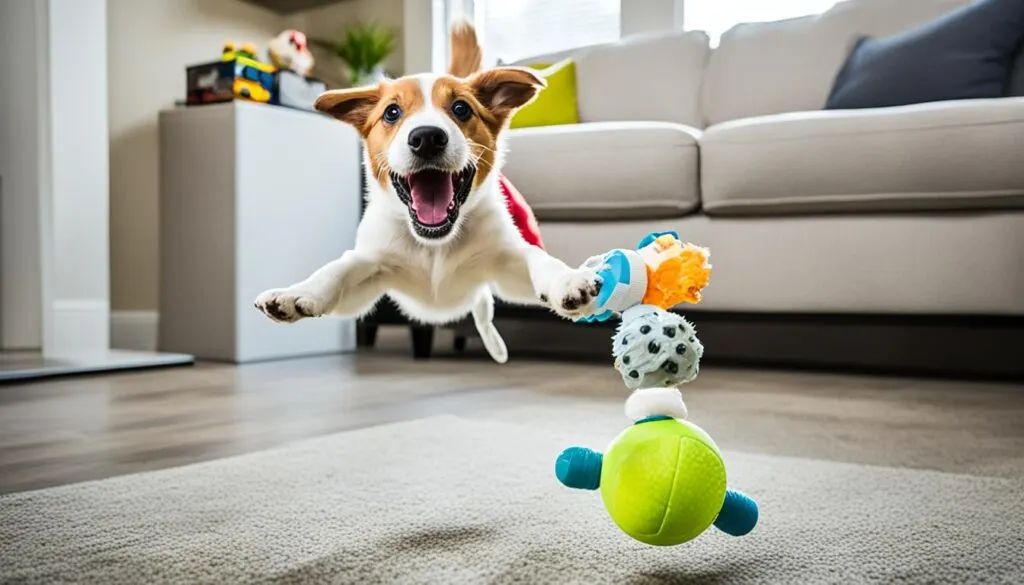Did you know that 8-month-old puppies are at a crucial stage of development where they may start exhibiting jumping and biting behaviors?
Whether it’s playfulness or seeking attention, these behaviors can become challenging to manage and may lead to frustration for puppy owners.
But worry not! With the right training techniques and consistency, you can teach your puppy to have better manners and curb their jumping and biting tendencies.
In this article, we will explore proven strategies to address this common issue and provide you with valuable puppy training tips for jumping and biting.
Your furry friend’s behavior is a reflection of their stage of development, and as responsible pet owners, it’s our duty to guide them towards appropriate behavior.
So, let’s dive in and discover effective methods to transform your 8-month-old puppy’s jumping and biting habits!

Click Here to Jump to a Section
Understanding the Behavior
Before diving into the training methods, it’s important to understand why your 8-month-old puppy is exhibiting jumping and biting behaviors.
Puppies often engage in these behaviors as a form of play or to seek attention.
By understanding the reasons behind their actions, you can tailor your training approach accordingly.
Jumping: Puppies may jump on people to greet them or to get closer to their faces, as it provides them with an opportunity for interaction and attention.
It’s a natural behavior that stems from their instinct to establish social bonds.
Biting: Puppies explore the world through their mouths, and biting is a normal part of their development.
However, it’s essential to teach them appropriate bite inhibition to prevent any harm to you and others.
Jumping and biting can also be a result of excess energy, boredom, or a lack of structure and boundaries.
Redirecting the Behavior
To address jumping and biting behaviors in your 8-month-old puppy effectively, consider the following training techniques:
- Ignoring: When your puppy jumps or bites, withhold attention by turning away, crossing your arms, and avoiding eye contact. This teaches them that these behaviors do not result in the desired interaction.
- Positive reinforcement: Reward your puppy for desirable behaviors, such as sitting or staying calm, by offering treats, praise, or playtime.
- Redirecting: Provide your puppy with appropriate alternatives, such as chew toys or puzzle feeders, to redirect their attention and energy.
- Boundary training: Establish clear boundaries, such as using baby gates or creating designated areas, to prevent your puppy from accessing certain spaces where jumping and biting are more likely to occur.
Consistency and repetition are key to successfully modify your puppy’s behavior. Remember to be patient and provide positive reinforcement for their progress.
| Common Causes of Jumping and Biting Behaviors | Solutions and Training Techniques |
|---|---|
| 1. Seeking attention | – Ignore the behavior, rewarding only calm behavior – Teach alternative behaviors to seek attention, such as sitting or offering a toy |
| 2. Playfulness and excitement | – Engage in regular exercise and play sessions to channel their energy – Teach appropriate play behavior and enforce breaks when necessary |
| 3. Lack of socialization | – Expose your puppy to various environments, people, and animals in controlled settings – Enroll your puppy in puppy socialization classes to learn appropriate behavior |
| 4. Teething | – Provide appropriate chew toys to satisfy their need to bite and relieve teething discomfort – Offer frozen treats or wet washcloths for soothing relief |
Positive Reinforcement Training
When it comes to addressing jumping and biting behaviors in an 8-month-old puppy, positive reinforcement training is an effective method. This approach involves rewarding your puppy for exhibiting desired behaviors, such as
.
By harnessing the power of positive reinforcement, you can effectively manage your puppy’s jumping and biting behavior.
This technique focuses on encouraging and reinforcing good behavior rather than punishing or scolding your puppy for their unwanted actions.
Here are some effective methods to teach an 8-month-old puppy not to jump and bite:
- 1. Treat-based training: Use small, bite-sized treats to reward your puppy when they exhibit calm behavior or engage in appropriate play. This reinforces the idea that good behavior leads to positive outcomes.
- 2. Clicker training: Incorporate a clicker tool into your training sessions. Click and treat your puppy when they refrain from jumping or biting, reinforcing the desired behavior.
- 3. Consistent verbal cues: Use consistent verbal cues such as “sit” or “stay” to redirect your puppy’s attention and reward them when they respond appropriately.
- 4. Redirecting their energy: Provide your puppy with alternative activities, such as interactive toys or puzzle games, to redirect their energy and prevent them from engaging in jumping and biting behavior.
Remember, consistency is key when using positive reinforcement training.
Set clear boundaries and be patient with your puppy as they learn. With time and consistent reinforcement, you can effectively manage your 8-month-old puppy’s jumping and biting behavior.
Positive Reinforcement Table
| Positive Reinforcement Techniques | Description |
|---|---|
| Treat-based training | Using small treats to reward desired behaviors, such as sitting calmly or engaging in appropriate play. |
| Clicker training | Incorporating a clicker tool to mark desired behaviors and provide a reward. |
| Consistent verbal cues | Using consistent verbal cues, such as “sit” or “stay,” to redirect behavior and provide positive reinforcement when responded to correctly. |
| Redirecting their energy | Providing alternative activities, such as interactive toys or puzzle games, to redirect your puppy’s energy into more appropriate behaviors. |

Consistency and Boundaries
When it comes to training an 8-month-old puppy, consistency is key in addressing jumping and biting behaviors.
Establishing clear boundaries and enforcing them consistently will help your puppy understand what is expected of them.
By setting boundaries, you can prevent your puppy from engaging in unwanted actions such as jumping and biting.
Here are some strategies to help you set boundaries and maintain consistency throughout the training process:
- Define a designated space: Create a specific area or room where your puppy can play and relax comfortably. Teach them that this is their safe space, reinforcing the idea that jumping and biting are not acceptable behaviors in this area.
- Use verbal cues: Introduce simple commands like “stop” or “no” when your puppy starts jumping or biting. Consistently use these cues whenever the unwanted behavior occurs, and reward them with praise and treats when they respond appropriately.
- Redirect their energy: Provide your puppy with appropriate outlets for their energy through regular exercise and interactive play. Engage them in activities that require mental stimulation and physical exertion, such as puzzle toys or obedience training sessions.
- Enforce time-outs: If your puppy continues to exhibit jumping and biting behaviors despite your efforts to redirect them, implement short time-outs. During a time-out, place your puppy in a quiet and secluded area for a few minutes to help them calm down. This will teach them that engaging in such behaviors results in a loss of attention and playtime.
Remember, patience is key when training an 8-month-old puppy.
Consistency and clear boundaries will gradually teach them what is expected and help them develop better manners over time.
Implementing consistent boundaries during training will go a long way in preventing an 8-month-old puppy from jumping and biting. By following these strategies, you can effectively address these behaviors and foster a well-behaved and obedient companion.
Distraction Techniques
Sometimes, dealing with a biting and jumping 8 month old puppy can be challenging.
Puppies often engage in these behaviors out of excitement or boredom.
However, you can effectively redirect their attention and prevent them from engaging in unwanted behaviors by using distraction techniques.
In this section, we will provide you with tips on using toys, treats, and other methods to redirect your puppy’s focus.
One effective method is to use interactive toys.
These toys are designed to keep your puppy mentally engaged, reducing their urge to jump and bite. Look for toys that require your puppy to problem-solve or work for treats.
Puzzle toys, treat-dispensing toys, and chew toys can be great options to keep your puppy entertained and distracted from inappropriate behavior.
In addition to toys, treats can also be a useful tool for distraction.
Keep a stash of high-value treats on hand, such as small pieces of cooked chicken or freeze-dried liver. When your puppy starts to jump or bite, redirect their attention by offering them a treat.
This helps shift their focus onto something positive and reinforces good behavior.
Another method to distract your puppy from biting and jumping is to use positive reinforcement training techniques.
Teach your puppy simple commands like “sit” or “down” and reward them with praise and treats when they respond correctly.
By redirecting their focus onto obedience commands, you can redirect their energy away from inappropriate behavior.
Remember to be consistent with your distraction techniques and always reward your puppy when they behave appropriately.
With time and practice, your 8 month old puppy will learn to replace jumping and biting with more desirable behaviors.

By employing effective distraction techniques, you can help your puppy overcome their jumping and biting behaviors. The next section will delve into the importance of socialization and puppy classes in shaping your puppy’s behavior.
Socialization and Puppy Classes
Socialization plays a crucial role in the overall development of an 8-month-old puppy.
By exposing your puppy to different people, animals, and environments, you can help them develop appropriate behavior and prevent excessive jumping and biting.
One effective way to socialize your puppy is by enrolling them in puppy classes.
These classes provide a controlled environment where your puppy can interact with other dogs and learn how to behave appropriately in various situations.
During puppy classes, trainers focus on teaching important social skills while also addressing behavior issues such as jumping and biting.
They can guide you on how to redirect these behaviors and promote positive interactions.
Here are some puppy training tips for jumping and biting that you can expect to learn in puppy classes:
- Teaching your puppy to greet people calmly
- Redirecting their attention to toys or treats when they start to jump or bite
- Using positive reinforcement to reward desired behavior
- Practicing impulse control exercises to discourage impulsive jumping and biting
By attending puppy classes, you not only provide your puppy with the necessary training but also create opportunities for them to socialize with other dogs and people in a controlled and supervised setting.
Remember, consistency is key in training your puppy.
Reinforce the lessons learned in puppy classes at home, and continue to expose your puppy to various social situations to reinforce their training and prevent unwanted behaviors.
Benefits of Puppy Classes:
| Benefits | Description |
|---|---|
| Structured Environment | Puppy classes provide a structured environment where your puppy can learn and interact under the guidance of professional trainers. |
| Socialization Opportunities | Your puppy will have the chance to socialize with other dogs and people, improving their social skills and reducing jumping and biting behavior. |
| Expert Guidance | Trainers can offer expert guidance and tailored advice to address your puppy’s specific jumping and biting issues. |
| Positive Reinforcement | Puppy classes focus on positive reinforcement training techniques, which help reinforce desirable behaviors and discourage jumping and biting. |
| Fun and Engagement | Puppy classes provide a fun and engaging learning environment, making training enjoyable for both you and your furry friend. |
Investing time and effort in puppy classes can have long-lasting benefits for your puppy’s behavior and social development.
These classes are an excellent opportunity to shape your puppy’s behavior positively while building a strong bond with them.
Seeking Professional Help
If you’ve been struggling to manage your 8 month old puppy’s persistent jumping and biting behaviors, it may be time to seek professional help.
Enlisting the assistance of a
or behaviorist can provide valuable guidance and expertise in addressing these issues.
A professional trainer or behaviorist will conduct a thorough assessment of your puppy’s behavior and devise tailored strategies to meet their specific needs.
They have the knowledge and experience to identify the underlying causes of jumping and biting, and can help you implement effective training techniques to modify your puppy’s behavior.
Working with a professional can offer numerous benefits.
They can guide you through the training process, provide demonstrations, and offer hands-on support.
Additionally, they can provide insights into puppy psychology and offer advice on how to effectively communicate with your furry friend.
Remember, seeking professional help is not a sign of failure, but rather a proactive and responsible step towards addressing your puppy’s jumping and biting behaviors.
With their expertise and your commitment to consistent training, you can help your puppy develop better manners and become a well-behaved member of your family.
